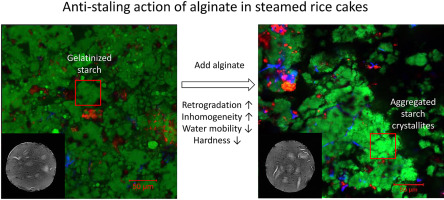当前位置:
X-MOL 学术
›
Food Hydrocoll.
›
论文详情
Our official English website, www.x-mol.net, welcomes your feedback! (Note: you will need to create a separate account there.)
Anti-staling of high-moisture starchy food: Effect of hydrocolloids, emulsifiers and enzymes on mechanics of steamed-rice cakes
Food Hydrocolloids ( IF 10.7 ) Pub Date : 2018-10-01 , DOI: 10.1016/j.foodhyd.2018.05.028 Jing Ai , Torsten Witt , Gary Cowin , Sushil Dhital , Mark S. Turner , Jason R. Stokes , Michael J. Gidley
Food Hydrocolloids ( IF 10.7 ) Pub Date : 2018-10-01 , DOI: 10.1016/j.foodhyd.2018.05.028 Jing Ai , Torsten Witt , Gary Cowin , Sushil Dhital , Mark S. Turner , Jason R. Stokes , Michael J. Gidley

|
Abstract High-moisture rice snacks, such as steamed rice cakes, develop firmness on storage which decreases shelf life significantly. By analogy with lower moisture bread systems, this staling was hypothesised to be due to a combination of starch retrogradation and moisture re-distribution. Therefore, food additives which are commonly used to retard starch retrogradation during bread staling, including enzymes, hydrocolloids and emulsifiers (alpha-amylase, alginate, xanthan, guar gum, carrageenan, carboxymethyl cellulose, distilled monoglyceride, and sodium stearoyl lactylate) were investigated for their anti-hardening effects in high-moisture rice snacks. The results showed that only alginate significantly reduced the firming rate of rice cakes. However, differential scanning calorimetry measurements surprisingly indicated that rice cakes with alginate had higher levels of starch retrogradation than the control after storage for 7 days. Magnetic resonance imaging results were characterised by a redistribution of signal intensity from the edge to the centre of rice cakes and the formation of high intensity regions. These features were stronger with the addition of alginate. We propose that the alginate forms a continuous phase with water that has high mobility, whereas the partially gelatinized starch granules are an included phase distributed within the continuous phase. The reduced hardness of aged rice cakes with alginate is more dependent on the soft continuous phase than the hard starch granules, therefore leading to a softer texture. This mechanism is different to that proposed to operate for lower water content baked systems, therefore hydrocolloid and other anti-staling agents which are effective in bread systems may not be applicable in higher moisture starchy foods.
中文翻译:

高水分淀粉食品的抗老化:亲水胶体、乳化剂和酶对蒸年糕力学的影响
摘要 高水分大米零食,如蒸年糕,在储存时会变硬,从而显着缩短保质期。通过与低水分面包系统类比,这种变质被假设是由于淀粉回生和水分重新分布的组合。因此,研究了通常用于延缓面包老化过程中淀粉回生的食品添加剂,包括酶、水胶体和乳化剂(α-淀粉酶、藻酸盐、黄原胶、瓜尔胶、角叉菜胶、羧甲基纤维素、蒸馏单甘油酯和硬脂酰乳酸钠)。它们在高水分大米零食中的抗硬化作用。结果表明,只有海藻酸盐才能显着降低年糕的紧实率。然而,差示扫描量热法测量令人惊讶地表明,在储存 7 天后,含有藻酸盐的年糕比对照具有更高水平的淀粉凝沉。磁共振成像结果的特点是信号强度从米糕边缘到中心重新分布,并形成高强度区域。添加海藻酸盐后,这些特征变得更强。我们建议藻酸盐与具有高流动性的水形成连续相,而部分糊化的淀粉颗粒是分布在连续相中的包含相。与硬淀粉颗粒相比,含海藻酸盐的陈年年糕硬度降低更依赖于软连续相,因此质地更柔软。
更新日期:2018-10-01
中文翻译:

高水分淀粉食品的抗老化:亲水胶体、乳化剂和酶对蒸年糕力学的影响
摘要 高水分大米零食,如蒸年糕,在储存时会变硬,从而显着缩短保质期。通过与低水分面包系统类比,这种变质被假设是由于淀粉回生和水分重新分布的组合。因此,研究了通常用于延缓面包老化过程中淀粉回生的食品添加剂,包括酶、水胶体和乳化剂(α-淀粉酶、藻酸盐、黄原胶、瓜尔胶、角叉菜胶、羧甲基纤维素、蒸馏单甘油酯和硬脂酰乳酸钠)。它们在高水分大米零食中的抗硬化作用。结果表明,只有海藻酸盐才能显着降低年糕的紧实率。然而,差示扫描量热法测量令人惊讶地表明,在储存 7 天后,含有藻酸盐的年糕比对照具有更高水平的淀粉凝沉。磁共振成像结果的特点是信号强度从米糕边缘到中心重新分布,并形成高强度区域。添加海藻酸盐后,这些特征变得更强。我们建议藻酸盐与具有高流动性的水形成连续相,而部分糊化的淀粉颗粒是分布在连续相中的包含相。与硬淀粉颗粒相比,含海藻酸盐的陈年年糕硬度降低更依赖于软连续相,因此质地更柔软。


























 京公网安备 11010802027423号
京公网安备 11010802027423号